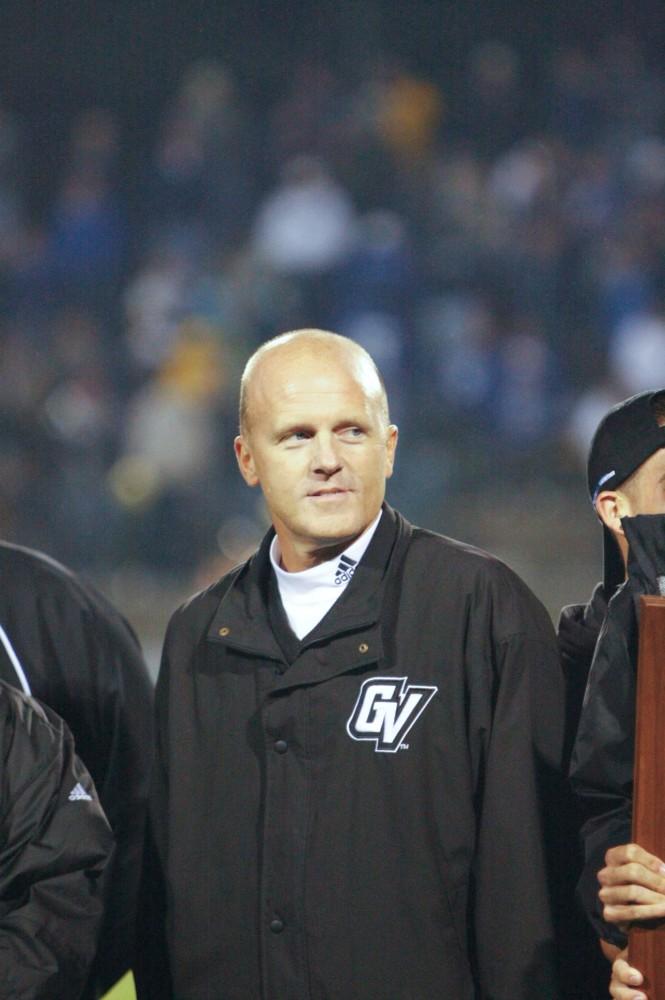GV sports turning out big success on slim budget

GVL Archive / Eric Coulter Athletic Director Tim Selgo
Apr 14, 2011
There are 20 varsity sports teams at Grand Valley State University, many of which are at the elite level of competition in NCAA Division II. Laker athletics have won seven straight Director’s Cups as the best varsity sports program in Division II, and GVSU is well on its way to its eighth-consecutive Cup.
Setting and maintaining the proverbial bar at such a high level is not easy, but it is not as expensive as some may expect.
GVSU Athletics is allocated less than 2.5 percent of the university’s overall budget, a ratio that is on par with similar, though less successful, Division II programs.
“The average is usually around 2.5 percent, and ours is traditionally less than that, usually around 2.2 or 2.3 percent,” said GVSU Athletic Director Tim Selgo, who is in his 15th year as the head of the Laker athletic department. “In those terms, I think our institution gets a pretty good bang for its buck in the intercollegiate athletic program.”
The majority of the money spent on GVSU varsity sports comes from the university’s general fund. In the 2010-2011 academic year, Laker Athletics received $5,378,025 from the school. This total is higher than most Division II schools, putting GVSU into the top one-third of Division II athletic programs in money received directly from their school.
But in terms of overall expenditures, GVSU is among the top in Division II due to its ability to raise money on its own.
“What we’re budgeted, from the university’s general fund, is not in the top 10 or 20 percent (in Division II),” Selgo said. “With our general fund money plus what we generate on our own, that is what puts us in the top 15 percent or so in Division II.”
Through ticket sales, merchandise and sponsorships, GVSU Athletics is able to add significantly to its overall budget.
“We started Louie’s Locker Room this year, and that’s been big for us this year,” said Charlie Read, GVSU assistant marketing director. “That’s the game day store at football, basketball volleyball and other games, which is a way we’ve been able to generate revenue that we didn’t have before.”
By generating revenue on its own, the athletic office is able to add about $1 million in added revenue to the available budget. This affords teams some discretionary spending, such as sending the track team to meets in California or the golf team to an outing in Pennsylvania.
Selgo added that the teams themselves are also responsible for helping out in the fundraising efforts.
“The money we generate ourselves allows us to do the ‘extras’,” Selgo said. “So maybe our soccer team will go to Florida for a tournament, and they’ll fundraise for that and bring dollars in to cover the costs. Many of our programs put on camps in the summer. A good portion of the revenue from their camps goes toward the operating budgets.”
The biggest chunk out of the athletic budgets goes straight to the Laker coaching staff. GVSU spends more than $3.5 million each year on coaches, including assistants and graduate hires, a total that is in the top 10 percent of all Division II programs.
The top earner is GVSU head football coach Matt Mitchell, who pulls in $138,061 per year. He is followed by men’s basketball coach Ric Wesley ($112,078) and women’s basketball coach Janel Burgess ($107,259).
“Our salaries are probably near the top because we have the best coaches in the league, by far,” Selgo said. “So we have high salaries, but our programs are very good and competitive, as a Division II program should be.”
Not included in the budget is the value of athletic scholarships. GVSU handed out the equivalent of 133.7 full-ride scholarships to more than 300 of the university’s 550-plus student-athletes who played in the 2010-2011 year, which accounts for a more than $2 million in free tuition, room, board and books for student athletes.
However, Selgo said there is a misconception that the majority of athletes on campus are getting their entire education paid for by the university.
“A very minute amount of student athletes have ever been on a full ride,” he said. “Almost all of our student-athletes are on a partial scholarship, and some more than most – it often depends on the sport. In football, when you have 36 scholarships to divide amongst 90 to 100 guys, you can do the math. We have not had many on a full ride at all.”
Selgo added that life as a student athlete is especially difficult because only a part of their schooling is covered, and it is very rare for an athlete to have time for varsity sports, academics and a job during the school year.
“The scholarships help fund part of their education, but the rest of it is funded just like other students on campus,” he said. “They’ve got to take out loans like every other student. Or somehow, someway have it paid for, whether it’s their parents or summer jobs helping them pay for their school.”
And in a time period where GVSU has to be as stringent as possible in its finances, Selgo said he knows that now more than ever it is his responsibility to keep costs low, but continue to keep performance on the field at an elite level.
“We watch every penny,” he said. “We don’t do anything that I would even come close to categorizing as extravagant. Every one of our teams is going to stay at a motel that has a free breakfast, if they don’t have a free breakfast then we’re not staying there, because it saves us money.”






















